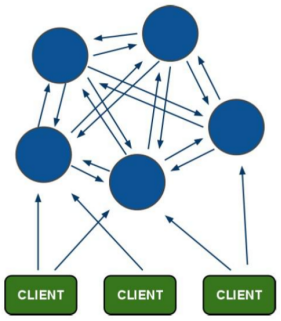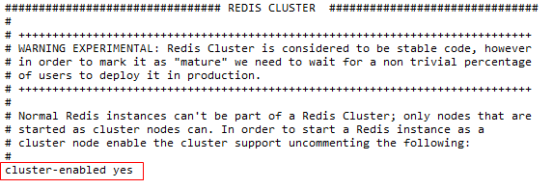1. SpringDataRedis简介
1.1 Redis
redis是一款开源的Key-Value数据库,运行在内存中,由ANSI C编写。企业开发通常采用Redis来实现缓存。同类的产品还有memcache 、memcached 、MongoDB等。
1.2 Jedis
Jedis是Redis官方推出的一款面向Java的客户端,提供了很多接口供Java语言调用。可以在Redis官网下载,当然还有一些开源爱好者提供的客户端,如Jredis、SRP等等,推荐使用Jedis。
1.3 Spring Data Redis
Spring-data-redis是spring大家族的一部分,提供了在srping应用中通过简单的配置访问redis服务,对reids底层开发包(Jedis, JRedis, and RJC)进行了高度封装,RedisTemplate提供了redis各种操作、异常处理及序列化,支持发布订阅,并对spring 3.1 cache进行了实现。
spring-data-redis针对jedis提供了如下功能:
1.连接池自动管理,提供了一个高度封装的“RedisTemplate”类
2.针对jedis客户端中大量api进行了归类封装,将同一类型操作封装为operation接口
ValueOperations:简单K-V操作
SetOperations:set类型数据操作
ZSetOperations:zset类型数据操作
HashOperations:针对map类型的数据操作
ListOperations:针对list类型的数据操作
1.4 Spring Data Redis入门小Demo
1.4.1准备工作
(1)构建Maven工程 SpringDataRedisDemo
(2)引入Spring相关依赖、引入JUnit依赖
(3)引入Jedis和SpringDataRedis依赖
<!-- 缓存 -->
<dependency>
<groupId>redis.clients</groupId>
<artifactId>jedis</artifactId>
<version>2.8.1</version>
</dependency>
<dependency>
<groupId>org.springframework.data</groupId>
<artifactId>spring-data-redis</artifactId>
<version>1.7.2.RELEASE</version>
</dependency>
(4)在src/main/resources下创建properties文件夹,建立redis-config.properties
redis.host=127.0.0.1
redis.port=6379
redis.pass=
redis.database=0
redis.maxIdle=300
redis.maxWait=3000
redis.testOnBorrow=true
(5)在src/main/resources下创建spring文件夹 ,创建applicationContext-redis.xml
<context:property-placeholder location="classpath*:properties/*.properties" />
<!-- redis 相关配置 -->
<bean id="poolConfig" class="redis.clients.jedis.JedisPoolConfig">
<property name="maxIdle" value="${redis.maxIdle}" />
<property name="maxWaitMillis" value="${redis.maxWait}" />
<property name="testOnBorrow" value="${redis.testOnBorrow}" />
</bean>
<bean id="JedisConnectionFactory" class="org.springframework.data.redis.connection.jedis.JedisConnectionFactory"
p:host-name="${redis.host}" p:port="${redis.port}" p:password="${redis.pass}" p:pool-config-ref="poolConfig"/>
<bean id="redisTemplate" class="org.springframework.data.redis.core.RedisTemplate">
<property name="connectionFactory" ref="JedisConnectionFactory" />
</bean>
maxIdle :最大空闲数
maxWaitMillis:连接时的最大等待毫秒数
testOnBorrow:在提取一个jedis实例时,是否提前进行验证操作;如果为true,则得到的jedis实例均是可用的;
1.4.2值类型操作
@RunWith(SpringJUnit4ClassRunner.class)
@ContextConfiguration(locations="classpath:spring/applicationContext-redis.xml")
public class TestValue {
@Autowired
private RedisTemplate redisTemplate;
@Test
public void setValue(){
redisTemplate.boundValueOps("name").set("itcast");
}
@Test
public void getValue(){
String str = (String) redisTemplate.boundValueOps("name").get();
System.out.println(str);
}
@Test
public void deleteValue(){
redisTemplate.delete("name");;
}
}
1.4.3 Set类型操作
@RunWith(SpringJUnit4ClassRunner.class)
@ContextConfiguration(locations="classpath:spring/applicationContext-redis.xml")
public class TestSet {
@Autowired
private RedisTemplate redisTemplate;
/**
* 存入值
*/
@Test
public void setValue(){
redisTemplate.boundSetOps("nameset").add("曹操");
redisTemplate.boundSetOps("nameset").add("刘备");
redisTemplate.boundSetOps("nameset").add("孙权");
}
/**
* 提取值
*/
@Test
public void getValue(){
Set members = redisTemplate.boundSetOps("nameset").members();
System.out.println(members);
}
/**
* 删除集合中的某一个值
*/
@Test
public void deleteValue(){
redisTemplate.boundSetOps("nameset").remove("孙权");
}
/**
* 删除整个集合
*/
@Test
public void deleteAllValue(){
redisTemplate.delete("nameset");
}
}
1.4.4 List类型操作
创建测试类TestList
(1)右压栈
/**
* 右压栈:后添加的对象排在后边
*/
@Test
public void testSetValue1(){
redisTemplate.boundListOps("namelist1").rightPush("刘备");
redisTemplate.boundListOps("namelist1").rightPush("关羽");
redisTemplate.boundListOps("namelist1").rightPush("张飞");
}
/**
* 显示右压栈集合
*/
@Test
public void testGetValue1(){
List list = redisTemplate.boundListOps("namelist1").range(0, 10);
System.out.println(list);
}
运行结果:
[刘备, 关羽, 张飞]
(2)左压栈
/**
* 左压栈:后添加的对象排在前边
*/
@Test
public void testSetValue2(){
redisTemplate.boundListOps("namelist2").leftPush("刘备");
redisTemplate.boundListOps("namelist2").leftPush("关羽");
redisTemplate.boundListOps("namelist2").leftPush("张飞");
}
/**
* 显示左压栈集合
*/
@Test
public void testGetValue2(){
List list = redisTemplate.boundListOps("namelist2").range(0, 10);
System.out.println(list);
}
运行结果:
[张飞, 关羽, 刘备]
(3)根据索引查询元素
/**
* 查询集合某个元素
*/
@Test
public void testSearchByIndex(){
String s = (String) redisTemplate.boundListOps("namelist1").index(1);
System.out.println(s);
}
(4)移除某个元素的值
/**
* 移除集合某个元素
*/
@Test
public void testRemoveByIndex(){
redisTemplate.boundListOps("namelist1").remove(1, "关羽");
}
1.4.5 Hash类型操作
创建测试类TestHash
(1)存入值
@Test
public void testSetValue(){
redisTemplate.boundHashOps("namehash").put("a", "唐僧");
redisTemplate.boundHashOps("namehash").put("b", "悟空");
redisTemplate.boundHashOps("namehash").put("c", "八戒");
redisTemplate.boundHashOps("namehash").put("d", "沙僧");
}
(2)提取所有的KEY
@Test
public void testGetKeys(){
Set s = redisTemplate.boundHashOps("namehash").keys();
System.out.println(s);
}
运行结果:
[a, b, c, d]
(3)提取所有的值
@Test
public void testGetValues(){
List values = redisTemplate.boundHashOps("namehash").values();
System.out.println(values);
}
运行结果:
[唐僧, 悟空, 八戒, 沙僧]
(4)根据KEY提取值
@Test
public void testGetValueByKey(){
Object object = redisTemplate.boundHashOps("namehash").get("b");
System.out.println(object);
}
运行结果:
悟空
(5)根据KEY移除值
@Test
public void testRemoveValueByKey(){
redisTemplate.boundHashOps(“namehash”).delete(“c”);
}
运行后再次查看集合内容:
[唐僧, 悟空, 沙僧]
2.Redis Cluster
2.1 Redis-Cluster简介
2.1.1 什么是Redis-Cluster
为何要搭建Redis集群。Redis是在内存中保存数据的,而我们的电脑一般内存都不大,这也就意味着Redis不适合存储大数据,适合存储大数据的是Hadoop生态系统的Hbase或者是MogoDB。Redis更适合处理高并发,一台设备的存储能力是很有限的,但是多台设备协同合作,就可以让内存增大很多倍,这就需要用到集群。
Redis集群搭建的方式有多种,例如使用客户端分片、Twemproxy、Codis等,但从redis 3.0之后版本支持redis-cluster集群,它是Redis官方提出的解决方案,Redis-Cluster采用无中心结构,每个节点保存数据和整个集群状态,每个节点都和其他所有节点连接。其redis-cluster架构图如下:

客户端与 redis 节点直连,不需要中间 proxy 层.客户端不需要连接集群所有节点连接集群中任何一个可用节点即可。
所有的 redis 节点彼此互联(PING-PONG 机制),内部使用二进制协议优化传输速度和带宽.
2.1.2分布存储机制-槽
(1)redis-cluster 把所有的物理节点映射到[0-16383]slot 上,cluster 负责维护
node<->slot<->value
(2)Redis 集群中内置了 16384 个哈希槽,当需要在 Redis 集群中放置一个 key-value 时,redis 先对 key 使用 crc16 算法算出一个结果,然后把结果对 16384 求余数,这样每个key 都会对应一个编号在 0-16383 之间的哈希槽,redis 会根据节点数量大致均等的将哈希槽映射到不同的节点。
例如三个节点:槽分布的值如下:
SERVER1: 0-5460
SERVER2: 5461-10922
SERVER3: 10923-16383
2.1.3容错机制-投票
(1)选举过程是集群中所有master参与,如果半数以上master节点与故障节点通信超过(cluster-node-timeout),认为该节点故障,自动触发故障转移操作. 故障节点对应的从节点自动升级为主节点
(2)什么时候整个集群不可用(cluster_state:fail)?
如果集群任意master挂掉,且当前master没有slave.集群进入fail状态,也可以理解成集群的slot映射[0-16383]不完成时进入fail状态.

2.2搭建Redis-Cluster
2.2.1搭建要求
需要 6 台 redis 服务器。搭建伪集群。
需要 6 个 redis 实例。
需要运行在不同的端口 7001-7006
2.2.2准备工作
(1)安装gcc 【此步省略】
Redis 是 c 语言开发的。安装 redis 需要 c 语言的编译环境。如果没有 gcc 需要在线安装。
yum install gcc-c++
(2)使用yum命令安装 ruby (我们需要使用ruby脚本来实现集群搭建)
yum install ruby
yum install rubygems
Ruby,一种简单快捷的面向对象(面向对象程序设计)脚本语言,在20世纪90年代由日本人松本行弘(Yukihiro Matsumoto)开发,遵守GPL协议和Ruby License。它的灵感与特性来自于 Perl、Smalltalk、Eiffel、Ada以及 Lisp 语言。由 Ruby 语言本身还发展出了JRuby(Java平台)、IronRuby(.NET平台)等其他平台的 Ruby 语言替代品。Ruby的作者于1993年2月24日开始编写Ruby,直至1995年12月才正式公开发布于fj(新闻组)。因为Perl发音与6月诞生石pearl(珍珠)相同,因此Ruby以7月诞生石ruby(红宝石)命名
RubyGems简称gems,是一个用于对 Ruby组件进行打包的 Ruby 打包系统
(3)将redis源码包上传到 linux 系统 ,解压redis源码包
(4)编译redis源码 ,进入redis源码文件夹
make
看到以下输出结果,表示编译成功

(5)创建目录/usr/local/redis-cluster目录, 安装6个redis实例,分别安装在以下目录
/usr/local/redis-cluster/redis-1
/usr/local/redis-cluster/redis-2
/usr/local/redis-cluster/redis-3
/usr/local/redis-cluster/redis-4
/usr/local/redis-cluster/redis-5
/usr/local/redis-cluster/redis-6
以第一个redis实例为例,命令如下
make install PREFIX=/usr/local/redis-cluster/redis-1

出现此提示表示成功,按此方法安装其余5个redis实例
(6)复制配置文件 将 /redis-3.0.0/redis.conf 复制到redis下的bin目录下
[root@localhost redis-3.0.0]# cp redis.conf /usr/local/redis-cluster/redis-1/bin
[root@localhost redis-3.0.0]# cp redis.conf /usr/local/redis-cluster/redis-2/bin
[root@localhost redis-3.0.0]# cp redis.conf /usr/local/redis-cluster/redis-3/bin
[root@localhost redis-3.0.0]# cp redis.conf /usr/local/redis-cluster/redis-4/bin
[root@localhost redis-3.0.0]# cp redis.conf /usr/local/redis-cluster/redis-5/bin
[root@localhost redis-3.0.0]# cp redis.conf /usr/local/redis-cluster/redis-6/bin
2.2.3配置集群
(1)修改每个redis节点的配置文件redis.conf
修改运行端口为7001 (7002 7003 …)
将cluster-enabled yes 前的注释去掉(632行)

(2)启动每个redis实例
以第一个实例为例,命令如下
cd /usr/local/redis-cluster/redis-1/bin/
./redis-server redis.conf

把其余的5个也启动起来,然后查看一下是不是都启动起来了
[root@localhost ~]# ps -ef | grep redis
root 15776 15775 0 08:19 pts/1 00:00:00 ./redis-server *:7001 [cluster]
root 15810 15784 0 08:22 pts/2 00:00:00 ./redis-server *:7002 [cluster]
root 15831 15813 0 08:23 pts/3 00:00:00 ./redis-server *:7003 [cluster]
root 15852 15834 0 08:23 pts/4 00:00:00 ./redis-server *:7004 [cluster]
root 15872 15856 0 08:24 pts/5 00:00:00 ./redis-server *:7005 [cluster]
root 15891 15875 0 08:24 pts/6 00:00:00 ./redis-server *:7006 [cluster]
root 15926 15895 0 08:24 pts/7 00:00:00 grep redis
(4)使用 ruby 脚本搭建集群。
进入redis源码目录中的src目录 执行下面的命令
./redis-trib.rb create --replicas 1 192.168.25.140:7001 192.168.25.140:7002 192.168.25.140:7003
192.168.25.140:7004 192.168.25.140:7005 192.168.25.140:7006
出现下列提示信息
>>> Creating cluster
Connecting to node 192.168.25.140:7001: OK
Connecting to node 192.168.25.140:7002: OK
Connecting to node 192.168.25.140:7003: OK
Connecting to node 192.168.25.140:7004: OK
Connecting to node 192.168.25.140:7005: OK
Connecting to node 192.168.25.140:7006: OK
>>> Performing hash slots allocation on 6 nodes...
Using 3 masters:
192.168.25.140:7001
192.168.25.140:7002
192.168.25.140:7003
Adding replica 192.168.25.140:7004 to 192.168.25.140:7001
Adding replica 192.168.25.140:7005 to 192.168.25.140:7002
Adding replica 192.168.25.140:7006 to 192.168.25.140:7003
M: 1800237a743c2aa918ade045a28128448c6ce689 192.168.25.140:7001
slots:0-5460 (5461 slots) master
M: 7cb3f7d5c60bfbd3ab28800f8fd3bf6de005bf0d 192.168.25.140:7002
slots:5461-10922 (5462 slots) master
M: 436e88ec323a2f8bb08bf09f7df07cc7909fcf81 192.168.25.140:7003
slots:10923-16383 (5461 slots) master
S: c2a39a94b5f41532cd83bf6643e98fc277c2f441 192.168.25.140:7004
replicates 1800237a743c2aa918ade045a28128448c6ce689
S: b0e38d80273515c84b1a01820d8ecee04547d776 192.168.25.140:7005
replicates 7cb3f7d5c60bfbd3ab28800f8fd3bf6de005bf0d
S: 03bf6bd7e3e6eece5a02043224497c2c8e185132 192.168.25.140:7006
replicates 436e88ec323a2f8bb08bf09f7df07cc7909fcf81
Can I set the above configuration? (type 'yes' to accept): yes
>>> Nodes configuration updated
>>> Assign a different config epoch to each node
>>> Sending CLUSTER MEET messages to join the cluster
Waiting for the cluster to join....
>>> Performing Cluster Check (using node 192.168.25.140:7001)
M: 1800237a743c2aa918ade045a28128448c6ce689 192.168.25.140:7001
slots:0-5460 (5461 slots) master
M: 7cb3f7d5c60bfbd3ab28800f8fd3bf6de005bf0d 192.168.25.140:7002
slots:5461-10922 (5462 slots) master
M: 436e88ec323a2f8bb08bf09f7df07cc7909fcf81 192.168.25.140:7003
slots:10923-16383 (5461 slots) master
M: c2a39a94b5f41532cd83bf6643e98fc277c2f441 192.168.25.140:7004
slots: (0 slots) master
replicates 1800237a743c2aa918ade045a28128448c6ce689
M: b0e38d80273515c84b1a01820d8ecee04547d776 192.168.25.140:7005
slots: (0 slots) master
replicates 7cb3f7d5c60bfbd3ab28800f8fd3bf6de005bf0d
M: 03bf6bd7e3e6eece5a02043224497c2c8e185132 192.168.25.140:7006
slots: (0 slots) master
replicates 436e88ec323a2f8bb08bf09f7df07cc7909fcf81
[OK] All nodes agree about slots configuration.
>>> Check for open slots...
>>> Check slots coverage...
[OK] All 16384 slots covered.
2.3连接Redis-Cluster
2.3.1客户端工具连接
Redis-cli 连接集群:
redis-cli -p 主机ip -p 端口(集群中任意端口) -c
-c:代表连接的是 redis 集群
测试值的存取:
(1)从本地连接到集群redis 使用7001端口 加 -c 参数
(2)存入name值为abc ,系统提示此值被存入到了7002端口所在的redis (槽是5798)
(3)提取name的值,可以提取。
(4)退出(quit)
(5)再次以7001端口进入 ,不带-c
(6)查询name值,无法获取,因为值在7002端口的redis上
(7)我们以7002端口进入,获取name值发现是可以获取的,而以其它端口进入均不能获取
2.3.2 SpringDataRedis连接Redis集群
修改品优购工程 在pinyougou-common工程添加spring 配置文件
applicationContext-redis-cluster.xml
<?xml version="1.0" encoding="UTF-8"?>
<beans xmlns="http://www.springframework.org/schema/beans"
xmlns:xsi="http://www.w3.org/2001/XMLSchema-instance" xmlns:p="http://www.springframework.org/schema/p"
xmlns:context="http://www.springframework.org/schema/context"
xsi:schemaLocation="http://www.springframework.org/schema/beans
http://www.springframework.org/schema/beans/spring-beans.xsd
http://www.springframework.org/schema/context
http://www.springframework.org/schema/context/spring-context.xsd">
<!-- 加载配置属性文件 -->
<context:property-placeholder ignore-unresolvable="true" location="classpath:properties/redis-cluster-config.properties" />
<bean id="redis-clusterConfiguration" class="org.springframework.data.redis.connection.redisClusterConfiguration">
<property name="maxRedirects" value="${redis.maxRedirects}"></property>
<property name="clusterNodes">
<set>
<bean class="org.springframework.data.redis.connection.redisClusterNode">
<constructor-arg name="host" value="${redis.host1}"></constructor-arg>
<constructor-arg name="port" value="${redis.port1}"></constructor-arg>
</bean>
<bean class="org.springframework.data.redis.connection.redisClusterNode">
<constructor-arg name="host" value="${redis.host2}"></constructor-arg>
<constructor-arg name="port" value="${redis.port2}"></constructor-arg>
</bean>
<bean class="org.springframework.data.redis.connection.redisClusterNode">
<constructor-arg name="host" value="${redis.host3}"></constructor-arg>
<constructor-arg name="port" value="${redis.port3}"></constructor-arg>
</bean>
<bean class="org.springframework.data.redis.connection.redisClusterNode">
<constructor-arg name="host" value="${redis.host4}"></constructor-arg>
<constructor-arg name="port" value="${redis.port4}"></constructor-arg>
</bean>
<bean class="org.springframework.data.redis.connection.redisClusterNode">
<constructor-arg name="host" value="${redis.host5}"></constructor-arg>
<constructor-arg name="port" value="${redis.port5}"></constructor-arg>
</bean>
<bean class="org.springframework.data.redis.connection.redisClusterNode">
<constructor-arg name="host" value="${redis.host6}"></constructor-arg>
<constructor-arg name="port" value="${redis.port6}"></constructor-arg>
</bean>
</set>
</property>
</bean>
<bean id="jedisPoolConfig" class="redis.clients.jedis.JedisPoolConfig">
<property name="maxIdle" value="${redis.maxIdle}" />
<property name="maxTotal" value="${redis.maxTotal}" />
</bean>
<bean id="jeidsConnectionFactory" class="org.springframework.data.redis.connection.jedis.JedisConnectionFactory" >
<constructor-arg ref="redis-clusterConfiguration" />
<constructor-arg ref="jedisPoolConfig" />
</bean>
<bean id="redisTemplate" class="org.springframework.data.redis.core.RedisTemplate">
<property name="connectionFactory" ref="jeidsConnectionFactory" />
</bean>
</beans>
添加属性文件redis-cluster-config.properties
#cluster configuration
redis.host1=192.168.25.140
redis.port1=7001
redis.host2=192.168.25.140
redis.port2=7002
redis.host3=192.168.25.140
redis.port3=7003
redis.host4=192.168.25.140
redis.port4=7004
redis.host5=192.168.25.140
redis.port5=7005
redis.host6=192.168.25.140
redis.port6=7006
redis.maxRedirects=3
redis.maxIdle=100
redis.maxTotal=600
2.4模拟集群异常测试
关闭节点命令
./redis-cli -p 端口 shutdown
(1)测试关闭7001 和7004, 看看会发生什么。
(2)测试关闭7001、7002、7003 会发生什么。






















 778
778











 被折叠的 条评论
为什么被折叠?
被折叠的 条评论
为什么被折叠?








